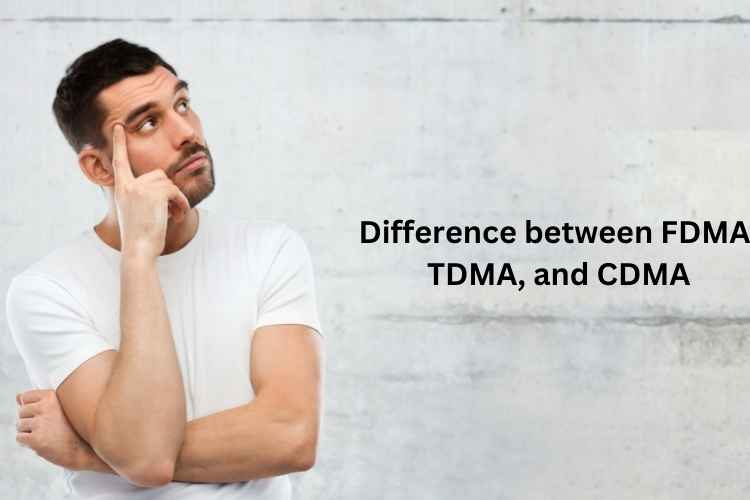In this blog we are going to tell you about Difference between FDMA, TDMA, and CDMA, so read this blog carefully to get the complete information.
When building a connection among the users sharing a similar radio spectrum, a traditional technique of analog modulation was used. But it may limit the data transferred within any provided channel, such methods include FM and AM. In this case, every channel can host only one conversation at an allotted time. Therefore, It requires a pair of users: one receiving and one transmitting.
Since a finite number of users would be able to maintain a spectrum of AM, it does not go well with the ever-expanding demands of today. But the good thing is Digital radio fixes this problem with a variety of modulation techniques that allow the conveyance of more information on a channel. The digital radio eventually came up with various ways in which it could accommodate more than a single conversation which means it multiplexed it inside one physical RF channel. It mainly uses three common ways to achieve it including FDMA, TDMA, and CDMA. These techniques are very effective but used in different aspects due to their different characteristics and features. Continue reading the article to know more about them along with the difference between FDMA, TDMA, and CDMA in detail.
What is FDMA?
FDMA or Frequency Division Multiple Access is a type of channelization protocol in which bandwidth is divided into several frequency bands. In this, each station is allotted a band to send data, and that band is reserved for a specific station all the time. The frequency bands of various stations are divided by small bands of unused frequency. These unused frequency bands are known as guard bands and it prevents the interference of stations. It is like an access technique in the data link layer in which the data link layer at each station says its physical layer to create a bandpass signal from the data passed to it. And thus the signal is established in the allocated band and there is no physical multiplexer present at the physical layer.
RELATED – Which of the following are right triangle congruence theorems?
What is TDMA?
TDMA or Time Division Multiple Access is the channelization protocol in which the bandwidth of a channel is distributed into several stations on a time basis. In this, there is a time slot provided to each station and the station can deliver data during that time slot only. Each station must know its starting time slot and the location of the time slot. TDMA needs synchronization between various stations. It is a kind of access technique in the data link layer and at each station data, the link layer tells the station to use the allocated time slot.
What is CDMA?
In CDMA or Code Division Multiple Access all the stations can deliver data simultaneously. It enables each station to deliver data over the whole frequency all the time. Multiple simultaneous transmissions are divided by a unique code sequence and each user is allocated a unique code sequence.
Difference between FDMA, TDMA, and CDMA
The following are the main difference points between FDMA, TDMA, and CDMA as mentioned below:
- Meaning
FDMA stands for frequency division multiple access in which bandwidth is divided into various frequency bands while TDMA stands for time division multiple access in which bandwidth is divided into various stations depending on the time. Lastly, CDMA stands for code division multiple access in which multiple transmissions are divided by a unique code sequence.
- Sharing
In FDMA, sharing of bandwidth among different stations takes place whereas in TDMA only the sharing of time of satellite transponder takes place. Meanwhile, in CDMA there is sharing of both which means bandwidth and time among different stations takes place.
- Codeword
There is no need for codewords in FDMA and TDMA while codewords are necessary for CDMA.
- Necessary Condition
In FDMA, there is only a need for guard bands between the adjacent channels which are very necessary whereas, in TDMA, a guard time of adjacent slots is very necessary. Meanwhile, in CDMA both guard bands and guard time are necessary.
- Synchronization
In FDMA and CDMA, synchronization is not required while in TDMA, Synchronization is needed.
- Mode of data transfer
In FDMA, the mode of data transfer is a continuous signal while in TDMA, the mode of data transfer is a signal in bursts, and in CDMA mode of data transfer is a digital signal.
- Flexibility
FDMA is a little flexible while TDMA is moderately flexible but CDMA is highly flexible.
The bottom line
Overall, all of these are modes of data transmission and communication that are effective but are used for different purposes. When talking about which is better, you can compare them. CDMA does not hold any limit on the capacity of the channel but this system is interference limited. On the other hand, FDMA is robustly built and very simple. TDMA is very flexible and fully digital and developed. Meanwhile, CDMA is also flexible and needs less frequency planning, and has a softer handover of signals. We hope you found this article helpful and understood the difference between FDMA, TDMA, and CDMA.
Conclusion
We Hope this blog is sufficient enough to provide the information about Difference between FDMA, TDMA, and CDMA. Thanks for reading this blog.
